In prepping for a webinar/presentation on online fundraising I wanted to update my 'stats' on online giving in 2015 and 2016 and in that research, it confirmed 3 things for me but I found 1 item that was quite surprising. I'll discuss all 4 of them with a focus on what they mean for you and online giving.
Let's get started with...
- Online giving continues to grow
- Email is growing in influence for driving donations
- Mobile is increasingly used for donations
1. Online giving continues to grow
Blackbaud's 2016 Charitable Giving Report has online giving growing by 7.9%. M + R's 2016 Benchmarks (covering 2015) has online giving up 19%. Network for Good's Digital Giving Index has online giving up 9% in 2015. And the 2016 Luminate Online Benchmark Report (covering July 2015 through June 2016 - just to make things complicated) has online giving up 4.89%.
So depending on your timeframe and preferred data source, online giving has grown at roughly 10% the past few years. This may seem a bit low given how much of our lives are digital and perhaps your own giving experience - like mine - is 95% online but the vast majority of giving is done through very large gifts - 6 figures plus - which, typically, do not come in online. These numbers only show how much money is actually raised online and not how much was inspired or because of online. That figure would a) be impossible to figure out and b) be much much larger.
Website traffic rates are growing at about 20% each year and 'busy-hour' traffic rates (the business 60 minute period) grew 51% in 2016. So the sheer volume of donors and potential donors visiting your website is growing each year and that alone will continue to bring online donations up along with it.
Also of note, overall giving, in those same reports, has been growing at about 1% (Blackbaud), 2% (Network for Good), or 4% (Giving USA). So while giving is growing, online giving is growing at a much quicker rate - a trend that has been in play for a few years now.
What This Means for You
Hopefully, this is justification for you and your team to continue investing in your online fundraising strategies - which should go beyond your donation page (although that is really important) - and overall digital work. This is a growth trend that will only continue to go up so if you are still fighting for budget, expertise, or time to use on digital, now is the time! Your website and digital strategies will never produce lower results than they do right now.
2. Email is growing in influence for driving donations
Emails can seem so 'old school' if you've been in the online fundraising game for a while with social media and Snapchat 'all the rage' as the kids say (do kids say that?). And while there are some potentially worrying signs with email - list growth slowed a bit (according to M + R and the Luminate benchmarks), response rates also dipped (M + R), and open rates dropped a bit (M + R and Luminate) - it remains a critical driver of online revenue.
And the value of email to your online fundraising may just be picking up. Take this from Dunham + Company:

M + R's 2016 Benchmark report also showed that email revenue was up 25% - outpacing online giving in general. So while some counting metrics may be slowing or dipping, the value of email fundraising is going up.
Dunham + Company also added this in relation to the info/stat above:
E-appeals are especially compelling to GenXers, Boomers and Silents, as nearly one third of them report that this channel prompted their online giving (31 percent, 29 percent and 28 percent, respectively). In contrast, just 23 percent of Millennials agreed that an e-appeal motivated their website giving.
So to me, this says inboxes are more competitive than ever but there is immense value if you can figure out how to use email well. Email, for more donors and 'higher value' donors, is increasingly important as a response mechanism.
What This Means For You
If you want to raise more money online you need to use email - more and better. Particularly for reaching those 'older' donors email is important. I'm not saying Direct Mail is dead and social media is a waste of time so bow before the golden altar of email. Just that there may be a temptation to hear people suggest email is dead or dying and you look at your open and click rates and may see 'evidence' to support it. Fight that notion. Look at the revenue from email and with email as a piece of integrated campaigns and I can almost guarantee you the value is there and possibly increasing.
3. Mobile is increasingly important and used for donations
If website traffic is growing and the value of emails for fundraising is going up, it makes sense that mobile is also growing and gaining in importance. In October 2016, according to StatCounter, mobile & tablet traffic finally overtook desktop traffic:
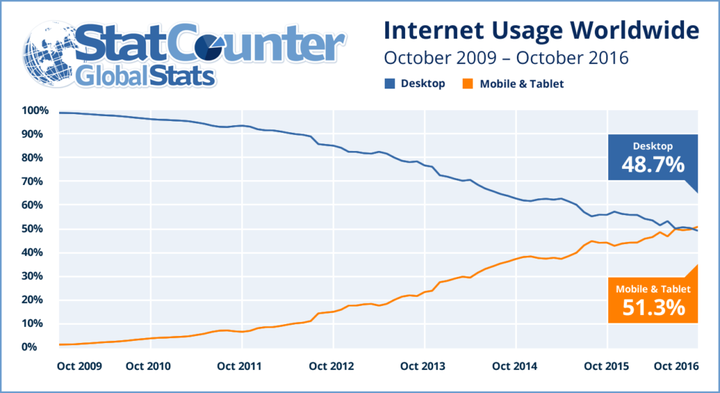
This isn't too surprising but still startling to see those graphs over time. And in the email world, mobile overtook desktop a few years ago already and continues to rise from Litmus' 2016 State of Email Report:
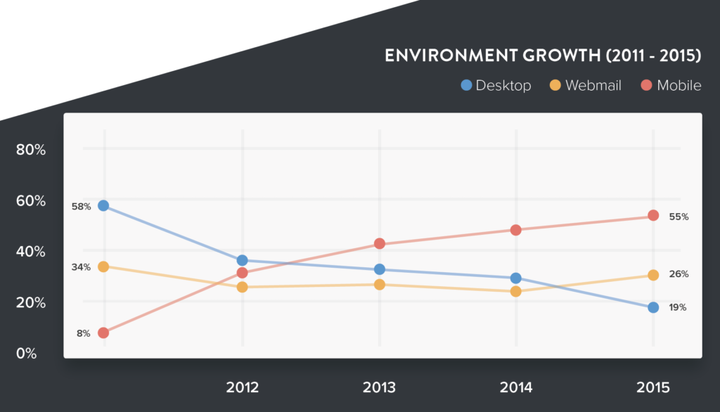
More traffic from mobile and email opens on mobile should result in things like this from Dunham + Company:
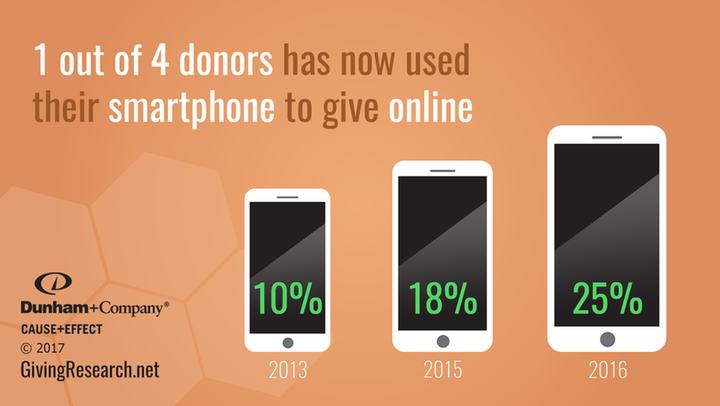
Or this from Blackbaud:

M + R's Benchmark report found that 13% of all online donations were made from a mobile device. I looked at three of our best clients (in terms of data) and their Q4 fundraising in 2016 and here's how mobile giving shook out:
- 16%
- 21%
- 18%.
More and more people are using their mobile phone to visit your website and open email which means they'll also use their mobile phone to make donations as well.
What This Means For You
Have you checked out your website on your mobile phone lately? Gone through a donation? Or email signup? It seems crazy that this is still in a blog post in 2017 but your site MUST be friendly and usable on mobile phones. And new strategies, tools, donation pages, campaigns, etc. MUST be thought of from a mobile first perspective.
Okay...
None of the above should be too surprising but they are great reminders that online is growing, email is important, and mobile is essential. This leads us to the...
1. 75+ donors make more online gifts in a year than any other generation
Hold up. What?
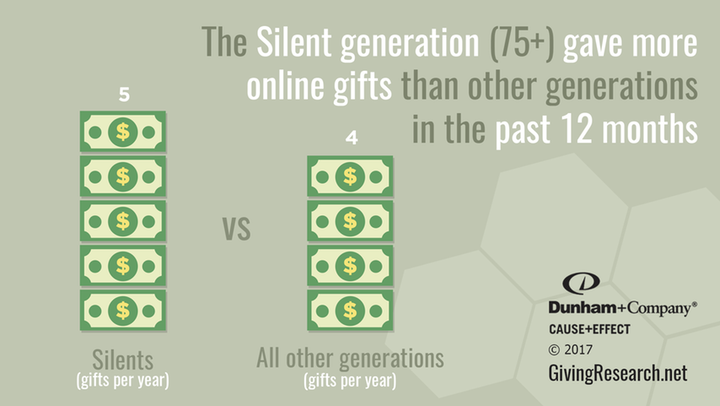
I had to read that a few times to make sure I was understanding it properly. And this research, while great, is survey based. I'm always wary of survey data when it comes to giving as people often over estimate how generous they are and don't always know or understand why they gave, where they gave, etc.
So I decided to dig into this with a few of our clients (the same three from the mobile check above). And check this out:
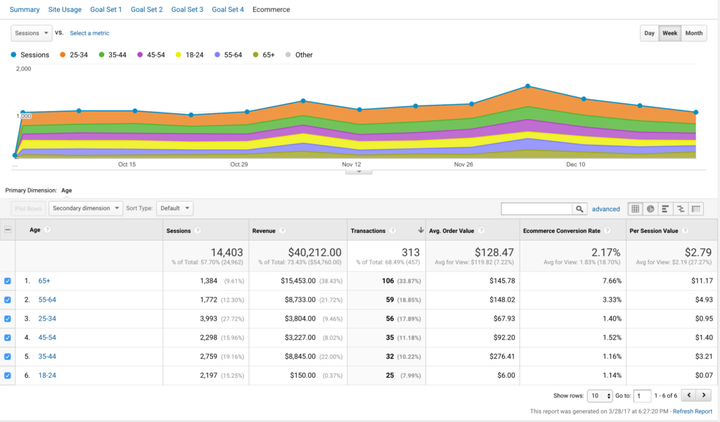
Boom. 65+ first and 55 - 64 were 2nd in transactions and revenue.
Okay, that client is a faith-based organization and has strong ties to a church denomination so could skew older. Then I checked the second client:
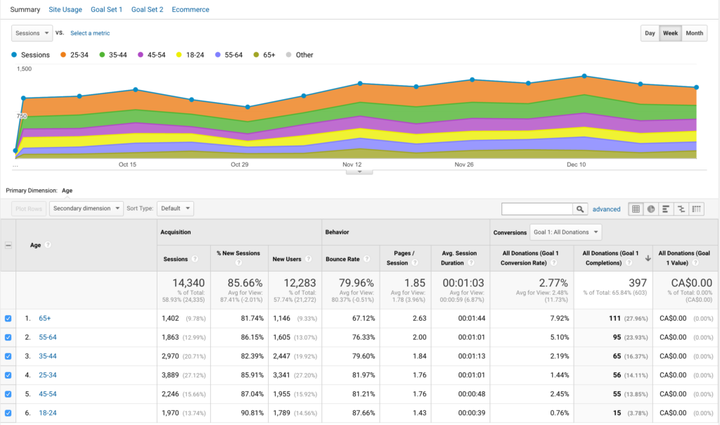
This client doesn't have eCommerce tracking set up so we can't see the revenue totals but we can see that 65+ accounted for 28% of donations - tops among the age groups - and 55 - 64 was 2nd.
Okay, this is getting a bit nutty... that organization is not like the first one (at all really) but we still ran both of their year-end campaigns (with great success) so maybe we have some 65+ online giving magic formula.
So I decided to check the third client that I'm working with now but didn't run their year-end campaign:
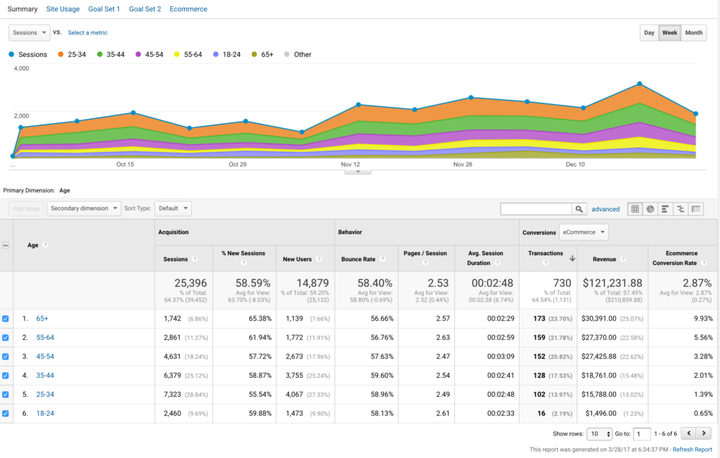
C'mon! 65+ first for transactions and revenue and, yep, 55 - 64 were 2nd (for transactions and barely 3rd for revenue).
Now three clients is still a very small sample size but we're talking about 1000+ donations and $250,000 in revenue from 3 very different organizations in the same time period that would back up what Dunham + Company found. That's pretty interesting and quite surprising if I'm honest (also of interest, when I added in gender as a secondary dimension, 55+ females accounted for 32%, 31%, and 22% of donations in that period - by far the most 'valuable' Age/Gender group).
Maybe this isn't surprising to you and you're thinking I should've known or seen that sooner. And perhaps your right. I'll certainly be paying more attention moving forward and that's what's most important here. What do you do with this information?
What This Means For You
There are many applications here but four things that stand out are:
- Make your website simpler
- Work harder to reduce online donation friction
- Have better and easier to access 'customer support'
- Target older donors with online advertising
1. Make your website simpler
Think of your grandmother using your website. Or your old Uncle Jim. Can they get around? Is it clear to them where to go, what they can do, and who you are?
2. Work harder to reduce online donation friction
With older donors, you have to overcome some trust issues with Credit Cards and payments online that you probably don't have to as much with younger donors so they are already a bit higher on the anxiety side of the equation. Simpler forms. Fewer fields. Easier to fill out. Trust marks everywhere!
3. Have better and easier to access 'customer support'
Have a phone number where they can call in and make a donation readily available. Provide a link somewhere on your site talking about other ways to give. Provide a privacy policy. Answer some frequently asked questions. When older donors run into problems or can't find something, they'll look for help more often than a younger donor (who will just leave or try to figure it out themselves).
4. Target older donors with online advertising
You may have removed older donors from targeting believing they won't give online. If so, looks like you may have been wrong. And the nice thing (potentially) about targeting older donors is they (may) be targeted less by other brands looking to acquire customers. I don't have any data there and this exercise has taught me my assumptions based on older consumers may be way off base, but even if competition is high, this age demographic seems like they are worth the investment.
So...
Online giving continues to grow and will continue to grow. Email has more value to fundraising today more than ever. And mobile is essential for great online giving - today and into the future. Older donors are increasingly interacting and giving online - possibly even your most active online donor. Be sure to keep things simple, reduce friction, support them, and consider targeting them. Good luck!
This was originally published on recharity.ca and can be read in full here.
